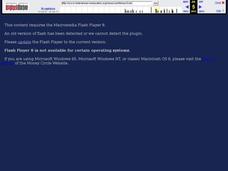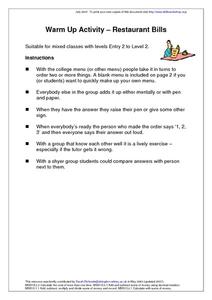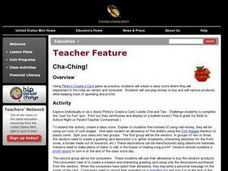Curated OER
Open & Operating: The Federal Reserve Responds to September 11
Students investigate the purpose of a central bank. In this economics/consumer mathematics lesson, students explore the actions of the Federal Reserve after the events of September 11, 2001. Students investigate the role of the central...
Curated OER
The Money Circle
Students investigate the Federal Reserve System. For this Mathematics/Economics lesson, students explore the role of the Federal Reserve in promoting a stable economic environment. In this multi-lesson unit of study, students explore...
Curated OER
Applied Maximum Minimum Problems
Students investigate the maximum and minimum of a graph as it related to cat food. In this calculus lesson, students analyze the amount of cat food a cat consumes, identifying the maximum and minimum amount. They graph their data and...
Curated OER
How Much Energy Do You Use?
Students take a survey of energy-consuming appliances in their homes and calculate the daily cost of operating these machines. They identify those appliances that consume the most energy and consider ways to reduce the amount of energy...
Curated OER
The Fundamental Theorem and IVP's
In this math worksheet, students practice solving the problems concerning the concept of energy consumption. They also review the Fundamental Theorem of Calculus.
Baylor College
Breathing Machine
Take a deep breath and have your class construct working models of a lung! Using 500ml plastic bottles as the chest cavity, and balloons for the lung and the diaphragm, learners work in groups to make a model. The models help them to...
Curated OER
Graph Those Stickers!
Students graph fruit. In this graphing lesson students create a graph using fruit label stickers. Students place a sticker on the graph when the fruit has been consumed.
Water
Global Water Supply Elementary School Curriculum
Water is the focus of an interdisciplinary unit that brings awareness to its daily use around the world and the importance of conservation. Worksheets challenge scholars to match words and definitions, trace, complete a maze, and solve a...
Curated OER
Restaurant Bills- Working With Money
In this consumer math activity, students working in small groups allow one member to choose two items. They add up the prices either mentally or using pencil and paper. They announce the answers in order to check the work.
Curated OER
How Much Money?
Sixth graders count money. In this money lesson, 6th graders count sets of coins and dollar bills. During specified activities, they total orders and calculate the amont of change a customer should receive. Students take turns...
Curated OER
Let's Go Value Shopping
Students count, figure change, and find the value of saving in a classroom store.
Curated OER
Percents: What's the Use?
Learners explore percentages in real world situations. In this percents lesson, students determine the final sales price after discounts. Learners interview community members and determine how percentages are used in the real world.
Curated OER
How are Things Lining Up
In this consumer math worksheet, students use the web to research and select a stock to buy. Students track and graph the stock’s activity over a two week period. The one page worksheet contains a blank graph and four questions. ...
Curated OER
New York City Delights: The Taxi Cab
You set the rate! Step into the shoes of a taxi driver in New York City, and also pretend to be a person who uses taxis to get around town. The class will conduct collaborative research to learn about the history of taxis. Then, they...
Curated OER
Is Bigger Always Better?
Explore rational numbers with the young mathematicians in your class. They will investigate decimals, fractions, and percents before ordering and comparing rational numbers. This multi-day unit includes differentiation activities and...
Sierra College
"Deals on Wheels!" Car Loan Project
Help your class members learn how to use their income wisely with a comprehensive lesson plan on calculating monthly car payments. Using basic math skills and online calculators, your learners will determine the total amount to be...
Teach Engineering
Household Energy Audit
Do you have an energy hog in your home? Individuals pick at least one room at home to determine the amount of energy the appliances consume. Using that information, pupils fill out a worksheet to determine the cost of running each...
Japan Society
Changing Times, Changing Styles: New Japanese Literary Styles of the Late Nineteenth Century
Focusing on Doppo's "Unforgettable People" and late nineteenth century Japanese literature, this resource also leads to discussions of form being dictated by content. Explore the development of new literary styles first-hand by...
Baylor College
Do Plants Need Light?
Turn your classroom into a greenhouse with a lesson plan on plant growth. First, investigate the different parts of seeds, identifying the seed coat, cotyledon, and embryo. Then plant the seeds and watch them grow! Measure the new plants...
Curated OER
Statistics and Shopping
Students explore the concept of using consumer data and statistics to aid in the consumer decision making process. In this consumer data and statistics lesson, students research consumer data and statistics. Students analyze the data...
Curated OER
Cha-Ching!
Students play the Pinky's Create a Card game for practice. Students create a class store where they experiment in the roles as vendor and consumer. Students use play money to buy and sell various products, while keeping track of spending...
Curated OER
Money & Work
Twelfth graders explain basic information concerning financial investments. They identify consumer rights and responsibilities and effective practices for purchasing consumer goods, services, housing and insurance. They list steps in...
Curated OER
Healthy Snacks. Healthy Packaging
Fourth graders research how to select the most cost-effective snacks. In this consumer practices lesson plan, 4th graders compare packaging labels and come to conclusions on how cost effective the product is. Students discuss their...
Curated OER
Transforming Food Energy: A Balancing Act
Students explain their role as consumers. They use a purchased calorimeter or make their own simple calorimeter to measure the energy content in selected foods. This interesting activity really gets students thinking about what they eat.
Other popular searches
- Consumer Math Worksheets
- Consumer Math Projects
- Consumer Math High School
- Consumer Math Activities
- Consumer Math Lessons
- Percentage Consumer Math
- Consumer Math Food
- Consumer Math Simulations
- Consumer Math Using Catalogs
- Money Consumer Math
- Consumer Mathematics
- Consumer Math Projects 40s

























